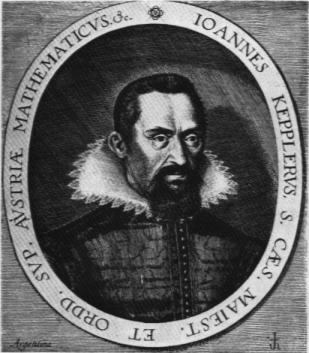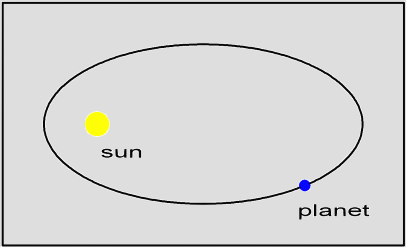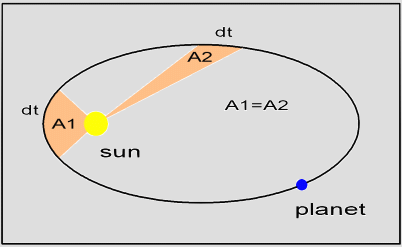“…who had devoted himself passionately to the pursuit of deep insight into the nature of natural incidents, and who, despite all inner and outer difficulties also reached his high aim.”
Albert Einstein in a pretext of a book about Johannes Kepler, 1949
Short life history: Johannes Kepler
* December 27, 1571 Weil der Stadt, †November 15, 1630 Regensburg
Johannes Kepler was born as child of protestant parents. He had six siblings, three of which died already at an early age. His father Heinrich Kepler, a learned merchant, hired out as mercenary soldier and scarcely was at home. When being a child Johannes fell ill with pocks, as a result of which he suffered from an eye illness and scars. In 1576 the family moved to Leonberg where Johannes attended first the German School and then the Latin School. In 1583 he passed the exam in Stuttgart and in 1584 he went to seminar Adelberg, a convent school. Two years later he was accepted at a higher seminar in Maulbronn, also a convent school. Made possible through a scholarship he began in 1589 with his studies in theology at the University of Tuebingen.
At this university also Michael Maestlin (1550–1631) was a teacher. He was professor for mathematics and astronomy and fought for spreading the Copernican theory. In this theory not the earth but the sun is at the centre of the solar system (heliocentric world view). In Tuebingen Kepler had first contacts with the heliocentric world view because he had discovered his liking for astronomy and mathematics. Kepler became a passionate believer. In 1591 he made his master’s degree successfully and continued his theological studies. In 1594 shortly before finishing his studies, he went to Graz to work there as landscape mathematician and teacher for mathematics.
In Graz the task of a landscape mathematician was to write astrological calendars. Kepler was very good in it and became quickly famous through his horoscopes. He continued to study mathematics and was busy with astronomical problems. In 1596 he published Mysterium cosmographicum, his first work on astronomy. The deeply religious Kepler was convinced that “the world” is built harmonically by the creator god.
In April 1597 he married Barbara Mueller. In the course of the counter-reformation in September 1598, all protestant clerics and teachers were driven out of Styria. Kepler had to leave the country. After some interim stops, he went in 1600 to the mathematician and court astronomer Tycho Brahe (1546–1601) in Prague.
Tycho Brahe was working for Emperor Rudolf II and had both the most exact empiric data and the most exact measuring instruments of his time. Kepler was assistant of Brahe and there he saw the possibility to test his astronomical theories empirically. As Brahe was more convinced of the geocentric world view and Kepler more of the heliocentric one their teamwork was disturbed. In the geocentric world view the earth, and not the sun is at the centre of the solar system. The deeply different characters of the two men added to this conflict. Thus for Kepler it was really difficult to get Brahe’s observation data, which were important for his work.
Brahe and Kepler together began the work about new, exact planet tables (Rudolfinian tables). Brahe set Kepler also the task to define the motion of the planet Mars. Astronomical observations had produced that the motion of Mars differed from a circle. This task was godsend for Kepler as he here, in the course of his thoughts, put the circular motion of planets into question and thought about elliptic ones. But this work was to keep him busy for some more years.
In 1601, after the death of Tycho Brahe, Kepler became imperialistic mathematician. Now Brahe’s astronomical observation data and his measuring instruments were at his disposal. In 1604 he wrote a report on a supernova watched by himself and worked on the Astronomia nova in which he wrote down his results about the orbit of planet Mars. In 1609 this work was published. In it are Kepler’s first two laws of planetary motion (see below).

copper engraving from Jakob von Heyden.

After Galileo Galilei (1564–1642) had watched the surface of the moon and the moons of Jupiter via a telescope and Kepler got to know this he also worked on optics. He developed an astronomical telescope and in 1611 he published a basic work on optics called Dioptrice. In July 1611 Kepler’s wife Barbara died. In 1612, after the death of Rudolf II, his brother Matthias became emperor. After hostile troops came to Prague, forayed plundering and drove the Lutherans out of the city, Kepler tried to get a job in Linz. With the approval of the new emperor Matthias he was allowed to take over the job of the landscape mathematician there.
In October 1613 he married his second wife, Mrs Susanne Reuttinger. In Linz Kepler worked still on the Rudolfinian tables. In his world harmony with which he also worked in Linz Kepler searched for a harmonic model of the universe. He worked out the theoretical basics of music. In July 1619 he published his results concerning the world harmony in a five-volume book. It was called Harmonices mundi. The fifth volume contained Kepler’s Third Law of Planetary Motion (see below). In Linz he completed two more works: the Epitome astronomiae copernicanae and the Tabulae Rudolphinae.
In 1615 Kepler’s mother Katharina was accused of wizardry in Leonberg. Kepler himself defended her. But it took six years until she was absolved. In 1618 the Thirty Years’ War had begun.
Kepler left Linz with his family in 1626 because of the pressure of the counter-reformation and went to Ulm. There he finished his work on the Rudolfinian tables which were printed in 1627 (Tabulae Rudolphinae). To facilitate the commerce he received in Ulm also the order to determine new measuring units.
In the year 1628 he went to the Silesian town Sagan to work there as mathematician for his protégé Albrecht von Wallenstein (1583–1634). On November 15, 1630 when being in Regensburg Johannes Kepler died. He was next to Galileo Galilei and Isaac Newton (1643–1727) one of the most important natural scientists of modern times. His grave in Regensburg was destroyed a few years later in the disturbances of the Thirty Years’ War.
Kepler’s laws of planetary motion:
Kepler’s First Law
The orbits of the planets are ellipses, with the sun at one focus of the ellipse.

Kepler has as the first one rejected the complete circular motion in his tests on planetary motion. Only with the observation of elliptic orbits did he find the long looked for accordance with Tycho Brahe’s measured data.
Kepler published this law in his 1609 work Astronomia nova.
Kepler’s Second Law
The line joining the planet to the sun sweeps out equal areas in equal times as the planet travels around the ellipse.

That means the planet moves faster when it is near the sun than away from the sun – its speed is not constant, it changes with its distance from the sun.
Also this law Kepler published in his 1609 work Astronomia nova.
Kepler’s Third Law
The ratio of the squares of the revolutionary periods for two planets is equal to the ratio of the cubes of their semimajor axes.
Kepler’s most important law. It shows the relationship between the period of the orbit of the planets and their average distances from the sun.
This law can be found in Kepler’s work Harmonices mundi, published in 1619.
A visit to the Kepler-Museum in Weil der Stadt.
Illustrations Credits:
Courtesy of the Kepler-Gesellschaft Weil der Stadt e.V.: 1, 2


 DEUTSCH
DEUTSCH